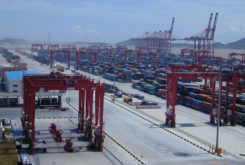After ironing out intricate competition and technical issues, Beijing has approved a much-awaited blueprint to create an IT-led economic powerhouse in southern China, and will unveil it in late February, according to South China Morning Post (SCMP).
Chinese Vice-Premier Han Zheng, the point man on Hong Kong and Macau affairs, recently gave the green light to the official document on the “Greater Bay Area” following extensive consultations with local governments, a Beijing source said to SCMP.
“No party or agenda, including even environmental protection, will be left behind by this all-inclusive blueprint,” the official said.
Another source said the details were expected to be disclosed on February 21, barring unforeseen circumstances, or before the start of the annual sessions of China’s top legislative and advisory bodies, known as the Two Sessions, on March 5.
Hong Kong and Macau Affairs Office director Zhang Xiaoming revealed on Saturday that the blueprint had been completed as “big progress” was made last year.
More than three years in the making, the Greater Bay Area was first mentioned in a development action plan jointly outlined by China’s top authorities on economic planning, commerce and foreign affairs to create a new economic growth engine by pooling together Hong Kong, Macau and nine neighbouring cities in Guangdong province.
The mega zone covers 56,500 square kilometres, has a combined population of about 67.6 million and accounted for 12.5 per cent of the country’s gross domestic product in 2016.
Macau Chief Executive and Hong Kong leader Carrie Lam Cheng Yuet-ngor has taken part in discussions on the scheme since August last year joining a leading group under China’s cabinet, the State Council.
Authorities were now working on the implementation plan, Zhang said in an interview with state broadcaster CCTV which was aired on Saturday night.
Hong Kong, Macau, Guangzhou and Shenzhen would be the central cities in the bay area, and each had their own unique positioning, he said.
Hong Kong will be the international finance, navigation and trade centre, as well as a transport hub. It will have the role of pushing finance, trade, logistics and professional services towards the high-end market.
Macau will be an international tourism city and a platform for trade with Portuguese-speaking countries.
Guangzhou will take a leading role as a national central city while Shenzhen will take a leading role as a special economic region and an innovative city, he said.
The planners hope the advantages these four cities enjoy can complement each other and offset the challenges brought by gaps in the legal and economic systems.
The plan is to integrate the 11 neighbouring cities into an IT-led economic powerhouse.
The international network and mature market economy of Hong Kong and Macau could have big potential when combined with the vast hinterland and market Guangzhou enjoyed, Han Zhang said.
“Under the new circumstances, Hong Kong and Macau still have their unique position and advantages that cannot be replaced,” Zhang said.
An internal study by an official think tank seen by the South China Morning Post said the crux of the Greater Bay Area integration was about putting “one country, two systems” into practice but differences in economic, tax, customs and legal systems that would ensure Hong Kong and Macau’s high degree autonomy have remained key challenges.



